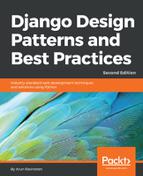Managing multiple servers in different states can be hard with Fabric. Configuration management tools such as Chef, Puppet, or Ansible try to bring a server to a certain desired state.
Unlike Fabric, which requires the deployment process to be specified in an imperative manner, these configuration-management tools are declarative. You just need to define the final state you want the server to be in, and it will figure out how to get there.
For example, if you want to ensure that the Nginx service is running at startup on all your web servers, then you will need to define a server state having the Nginx service both running and starting on boot. On the other hand, with Fabric, you will need to specify the exact steps to install and configure Nginx to reach such a state.
One of the most important advantages of configuration-management tools is that they are idempotent by default. Your servers can go from an unknown state to a known state, resulting in an easier server configuration management and reliable deployment.
Among configuration-management tools, Chef, and Puppet enjoy wide popularity since they were one of the earliest tools in this category. However, their roots in Ruby can make them look a bit unfamiliar to the Python programmer. For such folks, we have Salt and Ansible as excellent alternatives.
Configuration-management tools have a considerable learning curve compared to simpler tools, such as Fabric. However, they are essential tools for creating reliable production environments and are certainly worth learning.
